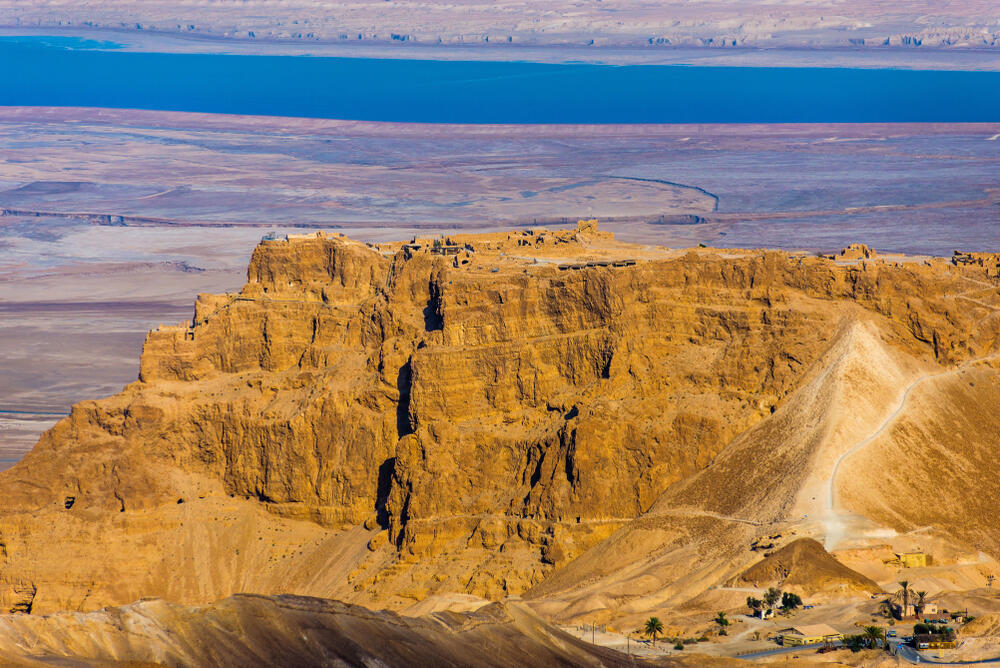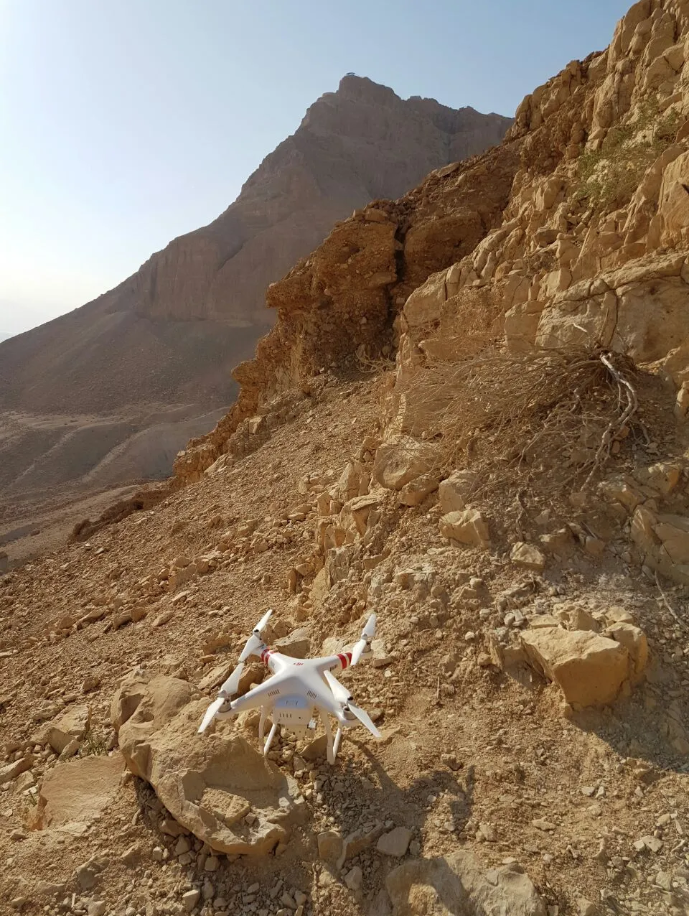Contrary to the myth, the Roman siege of the rebels at Masada in 73 CE lasted only a few weeks at most, as opposed to the several years previously held as gospel. This conclusion comes from research conducted by archaeologists at Tel Aviv University. Utilizing advanced drone technology, remote sensing, and 3D computer modeling, researchers gathered quantitative and objective data on the Roman siege system at Masada for the first time.
The research was conducted by the Masada Excavation Expedition, sponsored by the Neuenschwander family, under the leadership of Dr. Guy Stiebel from Tel Aviv University’s Institute of Archaeology. The study was a collaborative effort with Dr. Chai Ashkenazi, now head of geo-informatics at the Israel Antiquities Authority, and doctoral students Boaz Gross (Tel Aviv University and the Israeli Institute of Archaeology) and Omer Ze'evi (now at the University of Bonn). This research is part of a broader project applying innovative tools and posing new questions to understand what truly happened at Masada. The findings were published in the Journal of Roman Archaeology.
"In 2017, we resumed excavations at Masada for Tel Aviv University. This famous site has been extensively studied since the early 19th century and throughout the 20th century, yet contemporary research allows us to apply innovative tools, ask new questions, and gain fresh insights into what occurred there – before, during, and after the Great Revolt," Stiebel explained.
"We initiated a comprehensive project using remote sensing technologies via drones and aerial photography to collect precise information surrounding Masada, focusing on three main areas: water systems, pathways leading to the site, and the Roman siege system around Masada. The collected data is used to create highly detailed 3D computer models that provide a clear, high-resolution picture of the findings. Our current study focused on the siege system, which, due to its isolated location and desert climate, is the best-preserved Roman siege system on earth," he added.
Stiebel addressed the contradictions posed by previous research on Masada. "For many years, the myth persisted that the Roman siege of Masada was a prolonged and arduous event lasting about three years. In recent decades, researchers have begun to question this assertion for various reasons. We sought to examine the issue for the first time using innovative tools that allow for objective measurements."
Researchers employed remote sensing technologies using drones and aerial photography to collect data on all structures within the siege system – height, width, and depth – with extreme precision, down to millimeters. These data were used to construct a 3D computer model, enabling the calculation of construction volume and duration.
Dr. Ashkenazi stated, "There are reliable estimates of the amount of stones and earth a Roman soldier could move in a day for construction tasks," according to Ashkenazi. "It is known that 6,000 to 8,000 Roman soldiers participated in the Masada siege, and we objectively calculated how much time they spent building the entire siege system – eight camps and a stone wall surrounding most of the site. We found that the construction took less than two weeks, and based on ancient sources, one can estimate that the subsequent Roman attack and conquest lasted only a few weeks at most. Thus, we conclude that the entire siege lasted only a few weeks at most."
Stiebel concluded: "The narrative of Masada, the revolt, the siege and its tragic end, as described by Flavius Josephus, has long been part of Israeli DNA and the Zionist story, known worldwide. A prominent element of the myth is the siege's duration: the struggle of the formidable Roman army to breach the fortress and subdue its defenders. For years, the assumption was that the event spanned three years, but recent decades have seen researchers challenge this notion. Our study applied objective measurements using advanced technological tools to provide a scientifically grounded answer to this issue for the first time. According to our findings, we estimate that the Roman siege on Masada lasted only a few weeks at most. As empires do, the Romans came, saw and conquered, suppressing the rebellion at the isolated site swiftly and mercilessly."
He noted that the research will continue. "Our conclusions do not diminish the historical event's significance, and we still face significant questions, such as why the Romans invested so much effort in conquering a seemingly remote and insignificant site. To answer these intriguing questions, we continue with an extensive and innovative research project at Masada and its surroundings, aiming to gather data and conduct in-depth analysis in the labs of Tel Aviv University's Institute of Archaeology, in collaboration with numerous researchers, to shed new light on the mystery of what really happened there," Stiebel said.
History of Masada
Masada is a historic Jewish site located on a rock plateau at the edge of the Judean Desert and the Dead Sea Valley, approximately 15 miles south of Ein Gedi. In 2002, Masada was declared a UNESCO World Heritage Site. Previous excavations have shown significant activity at the site during two periods: the Herodian era (second half of the 1st century BCE) and the period of the First Jewish-Roman War (second half of the 1st century CE).
Herod built an elaborate and sophisticated system of palaces at Masada. He surrounded the plateau with a casemate wall featuring four gates and constructed three palace complexes. The northern palace, still prominent in the landscape today, is one of Masada's most recognizable features; it is built on three massive terraces, with the middle one being circular. The western palace served as a large residential building, with service wings, storerooms, workshops, and administrative areas. The third palace is a complex of three small buildings.
Additionally, large storerooms, a Roman-style bathhouse, bathing pools, and water storage facilities were constructed at Masada. The buildings are designed and decorated according to the best artistic and architectural traditions of Roman Herod's time, incorporating mosaics, frescoes and ornate columns. A wealth of artifacts – pottery, metal, and glass items, as well as parts of lavish furniture systems – attest to Masada's wealth and splendor during this period.
In the late stages of the Great Revolt, after the destruction of Jerusalem (70 CE), the last rebels and their families, numbering close to a thousand people, fled to Masada. They adapted the royal buildings to their needs. Most lived in the rooms of the casemate wall and small structures in various locations on the plateau; others resided in the small palace buildings. The other palaces were used for administrative purposes (the western palace) or for defense and observation (the northern palace). The rebels used the storerooms they found on-site and likely utilized the remnants of their contents. They also used the bathhouses after adapting them to their needs and added ritual baths. They built a synagogue in the casemate wall and even established a place for Torah study. Findings from the rebels' time at Masada include pottery and metal items, shekel coins from the revolt, ostraca (pottery shards with ink inscriptions), and scroll fragments, some biblical and others from external books and sectarian writings.
The Roman army, under the command of Flavius Silva, a late-1st-century Roman general and governor of the province of Iudaea and consul, laid a prolonged siege on Masada, encamping in camps around the plateau, where excavations also took place. The siege ramp poured by the Romans toward the plateau from the west was identified, intended to facilitate the breach inward.
Josephus detailed Masada's end in 73 CE and the mass suicide of the rebels within: "After the Romans breached Masada's walls, Eleazar ben Yair decided that death as a free man was preferable to the fate awaiting them at the hands of the Romans. In the final moments of the battle, ben Yair addressed the besieged and urged them to take their own lives rather than fall into captivity and slavery. Josephus recorded his speech, as recounted by two women who hid and survived. It is likely that Josephus embellished the account, yet it remains one of the important speeches in Israel's history. The rebels killed their own families, then cast lots among themselves. The 10 who drew lots killed each other, and the last, Eleazar, fell on his sword."




